THE RIP POST: It is Shin to the third power, not
“Shin Three,” right? Or is it either? And please explain
the significance of the name, and how you came up with
it.
SHIN3: Our name is “Shin to the power of three,” though
most people refer to us as
“Shin 3.” The superscript “3” throws them off!
We wanted a meaningful name, and, after extensive
research, found the Japanese
term “shin.” “Shin” has many meanings in Japanese, with
different kanji (Chinese
characters) representing the different meanings. We
chose the three meanings
which represented the ideals that we valued: (1)
heart-mind, (2) truth and (3) trust.
After being simply “Shin” for a short time, we realized
the significance of “three” in
all this. There were three of us in our ensemble; there
were the three kanjj
representing the three ideals we valued; and there was
the geometric shape of the
three-sided triangle--a shape which represented strength
and balance--another
concept we valued.
It seemed to us that in our ensemble, what was important
was that three people
could work together--sharing our strengths--to create
something that, working
alone, we as separate individuals might never
accomplish. So, to represent this
concept, we added the superscript “3” and became “Shin
to the power of three.”
RP: You are all professional people with occupations
(what are they?). How did you
come to be taiko players, and did any of you have any
background in performing of
any sort before?
SHIN3:
Audrey Nakasone is a microbiologist. Elaine Fukumoto is
a kindergarten teacher
who has studied Japanese folk dance. Joyce Layne is a
retired school district
human resources administrator and former senior high
school teacher and
counselor.
We were all drawn to the sounds, rhythms and movements
of taiko. Taiko was (still
is) a challenge, both physically and mentally!
None of us had any extensive experience in performing,
though Elaine did perform
Japanese folk dance, and Joyce played in her school
orchestra (a long time ago!).
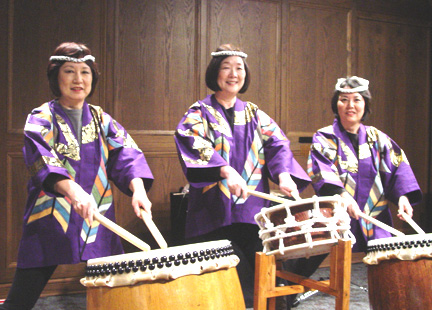
L to R: Fukumoto, Layne,
Nakasone.
"Three people could work together--sharing
our strengths--to create something that,
working alone, we as separate individuals
might never accomplish."---Shin3.(photo
courtesy of Shin3) |
RP: How did the three of you decide to form a group? It’s
quite unusual. Most people
think of taiko
groups as fairly large, as opposed to a
trio. But you do much more
than taiko as Shin3, correct?
SHIN3:
We knew each other, when we played with another taiko
group. When we left that
other group, we knew that we wanted to continue playing
taiko and it seemed natural
to get together and form an ensemble. We knew that we
shared common
interests and goals. For example, we wanted to explore
doing more than just
taiko. We wanted to be performers, entertainers. This is
why we do not use
“taiko” in our name.
We liked the challenge of performing as a trio. We find
that we are well-balanced; each of us brings a talent/skill to the group
which fills the needs for
what we do. Within our trio, there is no one leader; we
are all equals.
RP: I hate terms like “Mission Statement,” but...what do
you three consider to be the mission of Shin3?
SHIN3:
Our goal is to share with others some of the cultural
traditions of Japan, using the
performance arts of taiko, storytelling, music and
dance, in order to foster a greater
understanding of and appreciation for the cultural
diversity that makes our country unique. We hope that we, as third generation Japanese
Americans, serve as
models for other children, grandchildren, and great
grandchildren of immigrants.
We hope that they will be motivated to learn about and
appreciate their own cultural
traditions, as well as the traditions of other groups,
and that they will come to view
diversity as a rich source of strength to be valued.
RP: Please give me a description of a typical
Shin3 performance. Use any example
from your career together. Or if you do radically
different types of performances,
please summarize them.
SHIN3:
Our favorite performances are for school children (and
their parents!). We typically
start with a taiko piece. We may talk about the history
of taiko. Elaine will tell a
“kamishibai” story. Audrey will perform
shishimai--the
traditional “lion” dance. We
talk about the significance of the
shishimai, and the
craftsmen in Kyoto who made
Audrey’s shishi. Joyce may tell a traditional Japanese
folk tale. We like to get the
audience involved by showing them how to do a traditonal
“matsuri” dance, called
Awa Odori. Everyone, young and old, gets up and dances
the
Awa Odori. We
may then have a question and answer session.
RP: I know you sometimes perform at libraries with
storyteller Katy
Rydell, and that you help keep alive a particular visual style
of Japanese storytelling. Can
you explain and describe?
SHIN3:
It was our great good fortune to have been able to
perform with Katy, not just at
libraries, but in longer concert length performances.
Our performances usually
emphasize Japanese cultural traditions, and include “kamishibai.”
Before television
and movies, kamishibai men would ride on their bicycles
from village to village
telling stories using a sequence of pictures drawn on
paper. The kamishibai man
would use a wooden shadowbox, with an opening in the
front through which he
could show his pictures. As he told his story, he would
pull out each illustration,
revealing the next one underneath.
Tech savvy children of our time can still appreciate
this simple form of storytelling
using pictures!
RP: Do you write your own taiko pieces?
SHIN3:
Yes. We were taught basic composition techniques by
Ryan
Baker. Ryan is a
unique musician: he has a degree in music composition
and is also a taiko player
and taiko maker. He has composed taiko pieces, so he
understands both Western
music and taiko.
RP: It seems that taiko as it exists in the U.S. is quite
a bit different from Japan, and that
a lot more innovation is taking place since the relative
explosion of taiko popularity
here in the last 20 years or so. Innovation such as
combining various types of music
and instrumentation with taiko is not uncommon,. Fair
statement? Do you consider some of the
innovation as
going too far?
SHIN3:
The form of taiko that we play today, both here and in
Japan, is itself the result of
innovation--the combining of a Western music perspective
and the ancient
instrument known in Japan as taiko. As we know,
Grandmaster Daihachi Oguchi, a
fan of jazz, had the idea of combining various kinds of
taiko to be played together, in
the way a Western drummer, with a Western drum kit,
combines various sizes of
drums to produce a range of different sounds.
Additionally,
Oguchi sensei
infused
a new sense of dynamic rhythms (perhaps also the result
of his appreciation of jazz)
into this new way of playing taiko, and this is what
became so popular both here
and in Japan. So, the “history” of taiko, specifically
kumidaiko (two or more drummers playing more than
one type of taiko) here in the U.S.,
extends back only to 1968. Other than Japanese matsuri
or festival taiko drumming,
kumidaiko is making its own traditions on the fly! It’s
an evolving performing art,
both here and in Japan.
|
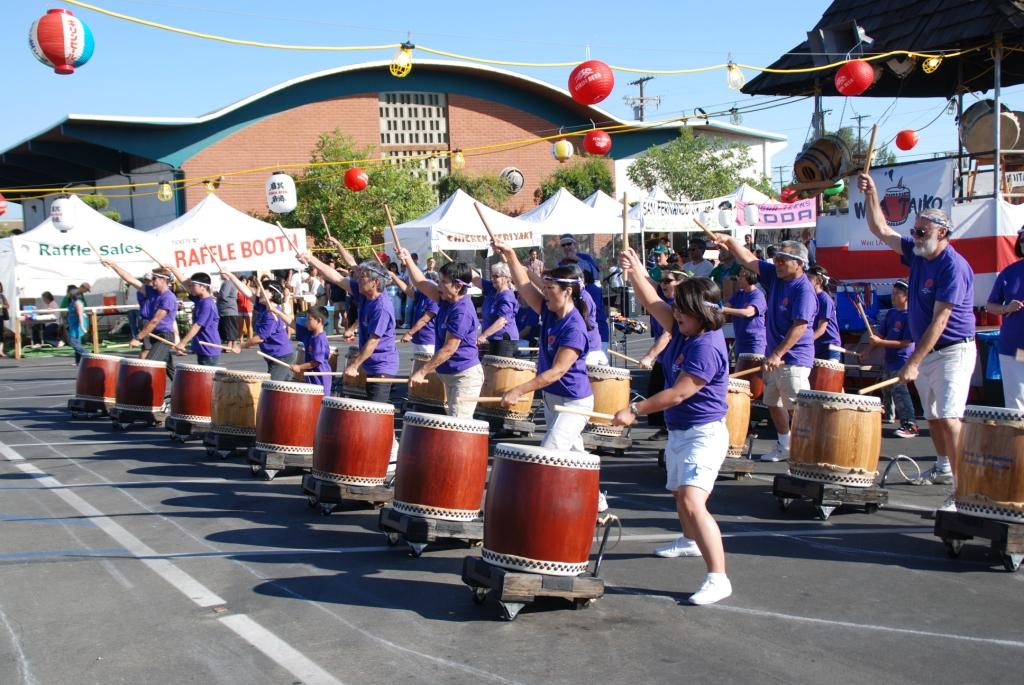
The West Los Angeles Buddhist Temple's West
L.A. Taiko, a performing group for all ages led
by Shin3, performs at the 2008 Obon Festival at
San Fernando Hongwanji Buddhist Temple.
(photo courtesy of W. L.A.
Buddhist Temple.) |
But perhaps it is true that here in the U.S., with music
and musicians from other
cultures so available and accessible, there has been
more innovation along the lines
of combining various types of music and instrumentation
with taiko. This is fine!
Like all experiments, some of the results simply don’t
work. However, if taiko is to
remain vital and exciting, innovation must be part of
the art.
We think your concern is that, with innovation running
rampant, taiko will lose its
cultural identity. This is a concern that many within
the taiko community here in the
U.S. share. We believe that the cultural identity or
integrity, if you will, of taiko, can
be preserved only where it has always resided--within
taiko players. You don’t
have to be Japanese to play taiko. But--huge but!--you
must know, understand and
appreciate the cultural history and traditions of taiko
and your role and
responsibility as a taiko player, to maintain that tie
with the tradition. We believe
that if you embrace that responsibility, then you
actually play taiko differently--in the
spirit of taiko, rather than as someone just beating a
drum. We try to make sure
that our taiko students understand and appreciate this
cultural tradition.
RP: Part of your work includes having started a new taiko
group at the West Los
Angeles Buddhist Temple. How did that come about, and
please describe the
group. What ages, types, skill levels are involved, etc.
SHIN3:
To clarify--we did not start a new
taiko group at West
LA. We were asked by the
minister at West LA Buddhist Temple, Rev. Fumiaki Usuki,
to teach a taiko class at
the temple.
When Rev. Usuki began his assignment at West LA Buddhist
Temple, he wanted
to start activities for temple members as a way of
encouraging involvement and
fellowship. One of his ideas was to start a taiko class.
His goal was not to produce
a performing group, but rather to give people the
opportunity to experience taiko as
a form of recreation. Since Rev. Usuki had been assigned
at the Los Angeles
Betsuin, where Shin3 is based and where we are all
members, he knew that
Audrey and Elaine had taught taiko. He asked if we would
be interested in
teaching the West LA class. Since we believe that one of
our responsibilities as
taiko players is to give back to the community by
sharing what we have learned,
and since we like teaching, we said yes.
We began with about 30 students, ages four to 84 and
everything in between.
The students were true beginners--no previous
experience--and we had no taiko!
Everyone in the class helped wrap packaging tape around
donated tires, and this
is how we began. Meanwhile, Rev. Usuki was determined to
make taiko! He
learned how to build taiko from Audrey’s friend, Chico
Jimenez. In a matter of a
few months, he and a few helpers built ten taiko--a real
accomplishment in such a
short period of time. He built an additional ten taiko
in the next year. Rev. Usuki’s
enthusiasm, energy, and unfailing support, as well as
the support of the temple
members, has been the reason for the progress and
success of the taiko class.
|
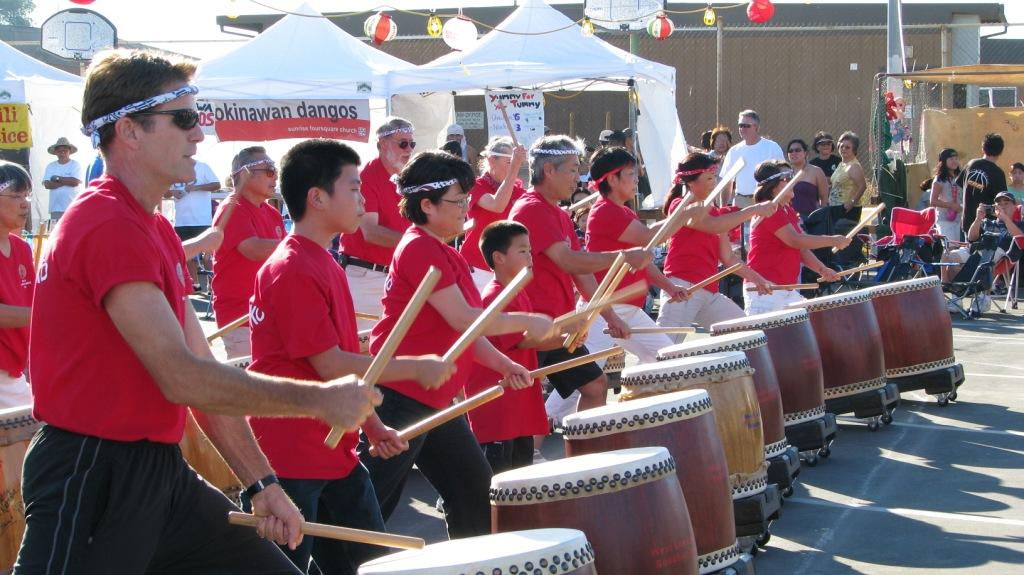
West L.A. Taiko performing at the San
Fernando Hongwanji
Buddhist Temple Obon Festival, 2008.
(photo
courtesy of W. L.A. Buddhist Temple.) |
RP: Some people reading this might assume it is unusual
to find women taiko players,
particularly oh, how shall I put this--who are past
thirty. Yet this is far from the
truth. The majority of taiko players in the U.S., I’ve
heard, is female. Without
using the awful word, “empowerment“ (please!), can you
give some observations
as to how and why this came to be?
SHIN3:
Two of us are past fifty and one of us is--let’s
see--beyond that! And yes--the last
we heard, approximately 75% of taiko players in the U.S.
are female. It would be
interesting to see an age distribution.
Why so many “older” female players? Well, taiko in the
U.S., as we mentioned
previously, started relatively recently--in 1968. We know
the first two taiko
groups formed in Northern California were
San Francisco
Taiko Dojo and
San Jose Taiko, and the first group formed in Southern
California was
Kinnara
Taiko. There wasn’t a lot of awareness about taiko and
fewer opportunities to learn
to play taiko. Anyhow, when you’re in college or
starting to work or just married
and raising children--who has time to indulge in
pounding a Japanese drum!
Consequently, many of us of that generation came late to
taiko.
Why more women than men? We don’t know! We think the men
are missing out!
RP: Many people think that taiko is fairly easy. “You
just hit the big drum.” Sure, it
requires practice, proper technique, but there is a
prevalent idea that it can’t be
that difficult. Your comments?
SHIN3:
In most cultures, the first instrument to evolve is
usually a drum of some sort.
Someone said that at its most basic, all you need is
your hand and something to
hit. So, we tell our class that, yes, it’s true that
anyone can hit a drum. Anyone can
hit a taiko. Furthermore, compared to other musical
instruments, like the piano, for
example, learning to play taiko is a whole lot quicker
and easier! And this is good,
because taiko can be accessible to people of all ages
and can accommodate
people at all levels of skill. Perhaps this is why taiko
has become so popular
among “just folks” and why community based taiko groups
are by far the most
popular way of playing of taiko, both here and in Japan.
Professional groups and
professional players are still few and far between.
Having said that, we believe that playing taiko well,
that is, using proper technique,
is extremely important. Since taiko is a strenuous
physical activity, good
technique can help alleviate injuries. Also, taiko is a
musical discipline, and the
challenge of mastering that discipline is good for the
body, the mind and the spirit.
RP: How and why is the tradition of taiko important to
you, and Japanese-Americans in
general?
SHIN3:
Taiko is important as one link among many that tie us to
Japan. As grandchildren
of Japanese immigrants, we are not far removed, in time,
from Japan, its history
and its cultural traditions. Taiko is an activity that
allows us to feel, in a small way,
like participants in the long flow of Japanese culture
and tradition. It’s a mostly
beautiful and wonderfully artistic tradition, so who
wouldn’t want to feel a part of
that! We strongly believe that everyone should know
about and value the traditions
of their ancestral homeland(s). We also believe that
fostering the continuation of
that tradition is very important and we think of our
performing and teaching as our
contribution to that end.
RP: Please tell about any especially rewarding moments
you’ve had as Shin3. Describe
in as much detail as possible.
SHIN3:
Two moments stand out. The first was when we
participated in the 2005 North
American Taiko Conference performance of “Korekara.” We
had just formed our
ensemble, when we got word that the Southern California
taiko groups were being
asked to participate in playing “Korekara,” a taiko
piece composed for the event, at
the opening of the Taiko Conference. No one knew who we
were. However,
during the practices and rehearsals, we felt that we
were accepted by and became
part of the taiko community. We were encouraged by the
support we received.
This acceptance and support was very important to us.
When we performed on
stage, as part of the taiko community, we were both
happy and humbled to be a
part that experience.. It was an event we will never
forget!
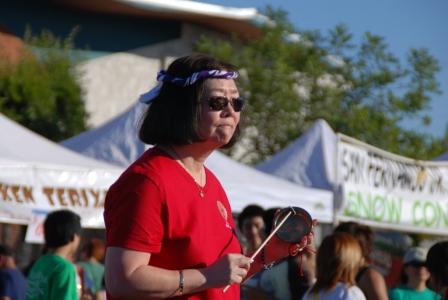 |
Joyce Layne keeps time
on the
kane (top.) Elaine Fukumoto (left) and
Audrey Nakasone (2nd from left) with young
members of West L.A. Taiko, 2008.
(photos courtesy of W. L.A. Buddhist
Temple.) |
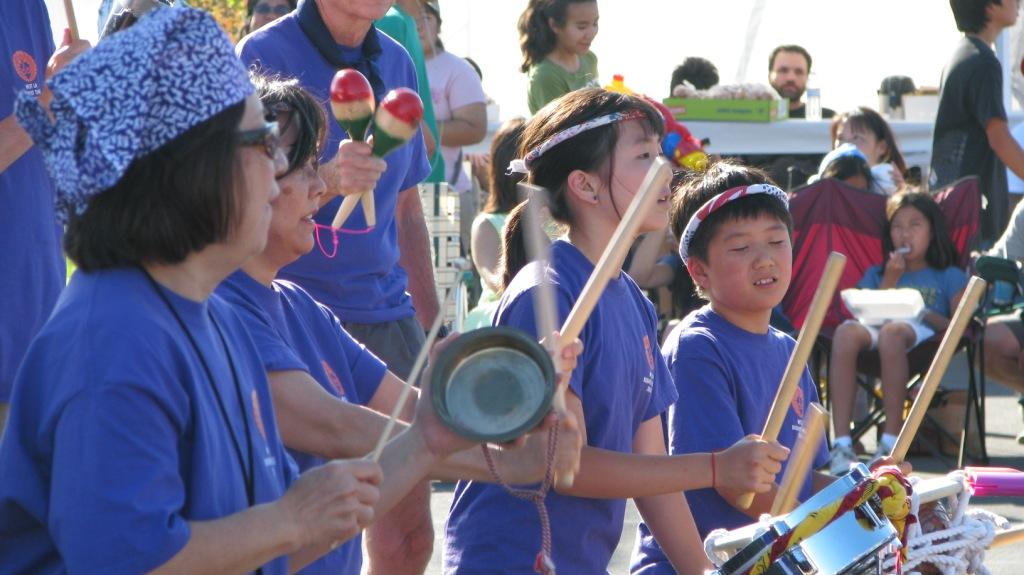 |
The second moment occurred the first time our class
performed in public, at the
West Los Angeles Buddhist Temple Obon. The class had
been playing taiko for
a mere eight months. They played the only two pieces
they knew! It was
wonderful to see their hard work pay off in front of
their family and friends!
After they finished,
George Abe, who had just performed
with Kinnara (they played
just before the class performed--a tough act to
follow!), said that he thought the
class played with true taiko spirit. Wow! To us, this
was the highest praise anyone
could give the class. We will always remember George’s
words!
RP: What future hopes and plans does Shin3 have?
SHIN3:
We hope that we can continue to find ways to challenge
the members of our class,
so that they have fun and grow as taiko players. We hope
that the bond which
has formed among the class members and their bond with
us will remain strong.
We plan to improve our own taiko compositions. We want
to find creative ways to
play taiko, and we certainly hope that we, like our
class, will continue to improve
our own skills.
We hope to travel to Japan, though the dollar to yen
exchange rate is
discouraging!
|
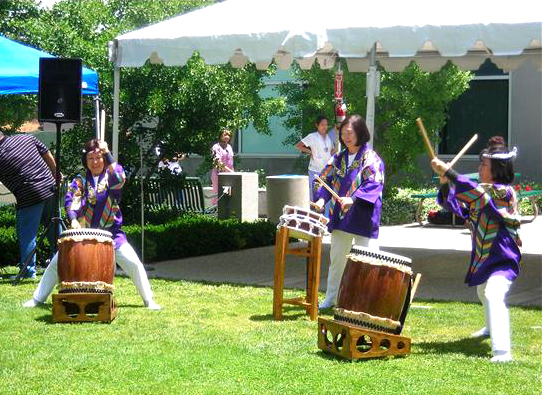
Shin3 Performs at University of California,
Irvine Medical Center.
L to R: Fukumoto, Layne, Nakasone.
(photo courtesy of Shin3) |
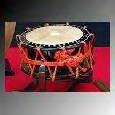 |
![]() The Rip Post Interview: Shin3
The Rip Post Interview: Shin3